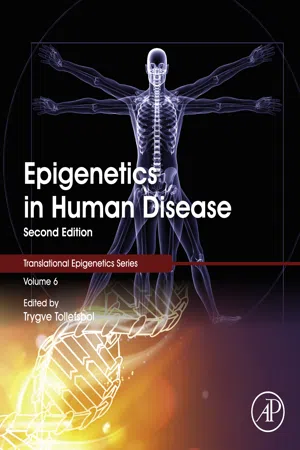
- 1,110 pages
- English
- ePUB (mobile friendly)
- Available on iOS & Android
Epigenetics in Human Disease
About This Book
Epigenetics in Human Disease, Second Edition examines the diseases and conditions on which we have advanced knowledge of epigenetic mechanisms, such as cancer, autoimmune disorders, aging, metabolic disorders, neurobiological disorders and cardiovascular disease. In addition to detailing the role of epigenetics in the etiology, progression, diagnosis and prognosis of these diseases, novel epigenetic approaches to treatment are also explored. Fully revised and up-to-date, this new edition discusses topics of current interest in epigenetic research, including stem cell epigenetic therapy, bioinformatic analysis of NGS data, and epigenetic mechanisms of imprinting disorders.
Further sections explore online epigenetic tools and datasets, early-life programming of epigenetics in age-related diseases, the epigenetics of addiction and suicide, and epigenetic approaches to regulating and preventing diabetes, cardiac disease, allergic disorders, Alzheimer's disease, respiratory diseases, and many other human maladies.
- Includes contributions from leading international investigators involved in translational epigenetic research and therapeutic applications
- Integrates methods and applications with fundamental chapters on epigenetics in human disease, along with an evaluation of recent clinical breakthroughs
- Presents side-by-side coverage of the basis of epigenetic diseases and treatment pathways
- Provides a fully revised resource covering current developments, including stem cell epigenetic therapy, the bioinformatic analysis of NGS data, epigenetic mechanisms of imprinting disorders, online epigenetic tools and datasets, and more
Frequently asked questions
Information
Epigenetic-Processes Driven Disorders and Therapeutics
Abstract
Keywords
18.1. What Is Epigenetics?
18.2. Introduction
18.2.1. DNA Methylation

18.2.2. Histone Modifications
18.2.2.1. Histone Acetylation, Histone Phosphorylation, Histone Methylation
Table of contents
- Cover image
- Title page
- Table of Contents
- Translational Epigenetics Series
- Copyright
- List of Contributors
- Preface
- Section I. Introduction
- Section II. Methodology
- Section III. Human Cancer
- Section IV. Neurological Disease
- Section V. Autoimmune Disease
- Section VI. Metabolic Disorders
- Section VII. Other Disoders/Diseases
- Section VIII. Development, Aging and Transgenerational Effects
- Section IX. Future Research
- Index